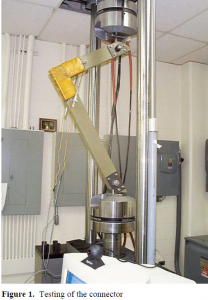Patrick J. Sedivy and Dr. Fernando S. Fonseca, Civil and Environmental Engineering
The Problem
Pultruded Fiber-Reinforced Polymer (FRP) structures are an attractive alternative to steel which is corrosive and heavy. However, FRP beams and columns cannot be connected using conventional methods such as bolting or welding. Anthony G. Cockbain demonstrated the potential of a monolithic sleeve connector.1 Although Cockbain’s research showed much promise for the sleeve connector, there were still several problems. The manufacturing process was extremely labor intensive and the connector needed to be stronger.
Results
In order to improve the manufacturing process, the connector was filament-wound. Although filament-winding the prototype was labor intensive, this process has much potential since it can be automated for mass production. Automated production is ideal because the toxic fumes coming from the resin create a health hazard and production costs are much lower.
The connector was tested with the same apparatus and methods used by Cockbain (Fig. 1). The test results indicated that the connector was not as strong as Cockbain’s. Although these results may be disappointing, the problem is not incorrigible. The weakness in the connector was probably caused by high resin content and low fiber content. Filament-winding usually produces parts with high resin content. However, the process may be refined to reduce the resin content of the connector to some extent.
Suggestions
Although filament-winding was demonstrated to be a feasible manufacturing process, it still needs to be refined. In order to reduce the resin content, clamps can be places over the glass fibers after they pass through the resin bath. This will remove the excess resin from fibers. Furthermore, since the resin thickens with time, the resin content can also be reduced by speeding up the winding process.
Two main things can be done to increase the strength of the connector. First, metal plates can be inserted on both sides of the connector between fiber layers. The metal plates will cover and strengthen the most vulnerable area of the connector. The metal plates should have several holes in them so that the layer of fibers beneath the plate can bond properly to the layer over the plate. Second, the inside corner, between the beam and the column, should be rounded so as to eliminate stress concentrations which seem to initiate failure.
References
- Cockbain, Anthony G. “A Composite Sleeve Connector for Pultruded Frames” MS Thesis, Brigham Young University, Provo, UT, August 1998.

